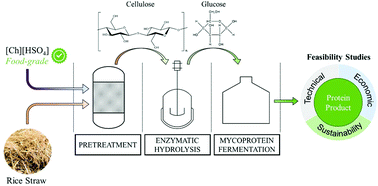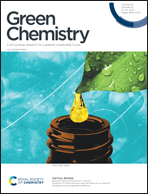Protein from renewable resources: mycoprotein production from agricultural residues†
Abstract
Globally, one in nine people suffer from undernourishment with evidence that this number is increasing. Additionally, due to the projected 50% increase in global population, the demand in worldwide animal-sourced protein is expected to double by 2050. Furthermore, not only are global animal protein supply chains susceptible to the effects of climate change, but they are also a significant contributor to greenhouse gas emissions and require large areas of arable land. Single cell proteins (SCPs) are an alternative protein source that offer a potential route to reduce the environmental impact of global protein consumption. One such SCP is Fusarium venenatum, which is a strain of mycoprotein widely sold under the brand name Quorn and is produced through the fermentation of the microorganism on glucose. However, this glucose still has a significant arable land-use burden associated with it. In order to mitigate this burden, sugars derived from agricultural lignocellulosic residues could be used, however, additional processing steps are required. In this work, exploratory research on fermentation of F. venenatum on sugars derived from lignocellulosic residues is presented. The food-grade ionic liquid [Ch][HSO4] was employed in combination with food-grade Celluclast 1.5L to extract glucose from rice straw residues, which resulted in an overall glucose yield of 42.4% compared to using non-food certified ionic liquid [TEA][HSO4], which yielded 92.8%. Based on these results, a Techno-Economic Analysis (TEA) and Life Cycle Assessment (LCA) were conducted after synthesising a biorefinery process model. TEA modelling outcomes highlighted that the crude mycoprotein paste product could be produced for $5.04 kg−1 ($40.04 per kg-protein). By conducting a retro-techno-economic analysis, it was shown that there is reasonable scope for reducing this price further by improving saccharification yields and utilising feedstocks with high cellulose contents. Furthermore, LCA results demonstrated significant sustainability benefits of lignocellulosic-derived mycoprotein, with greenhouse gas emissions less than 14% that of protein from beef. However, the most significant advantage of this technology is the minimal dependence on arable land compared to animal-sourced and plant-sourced proteins such as beef and tofu.



 Please wait while we load your content...
Please wait while we load your content...